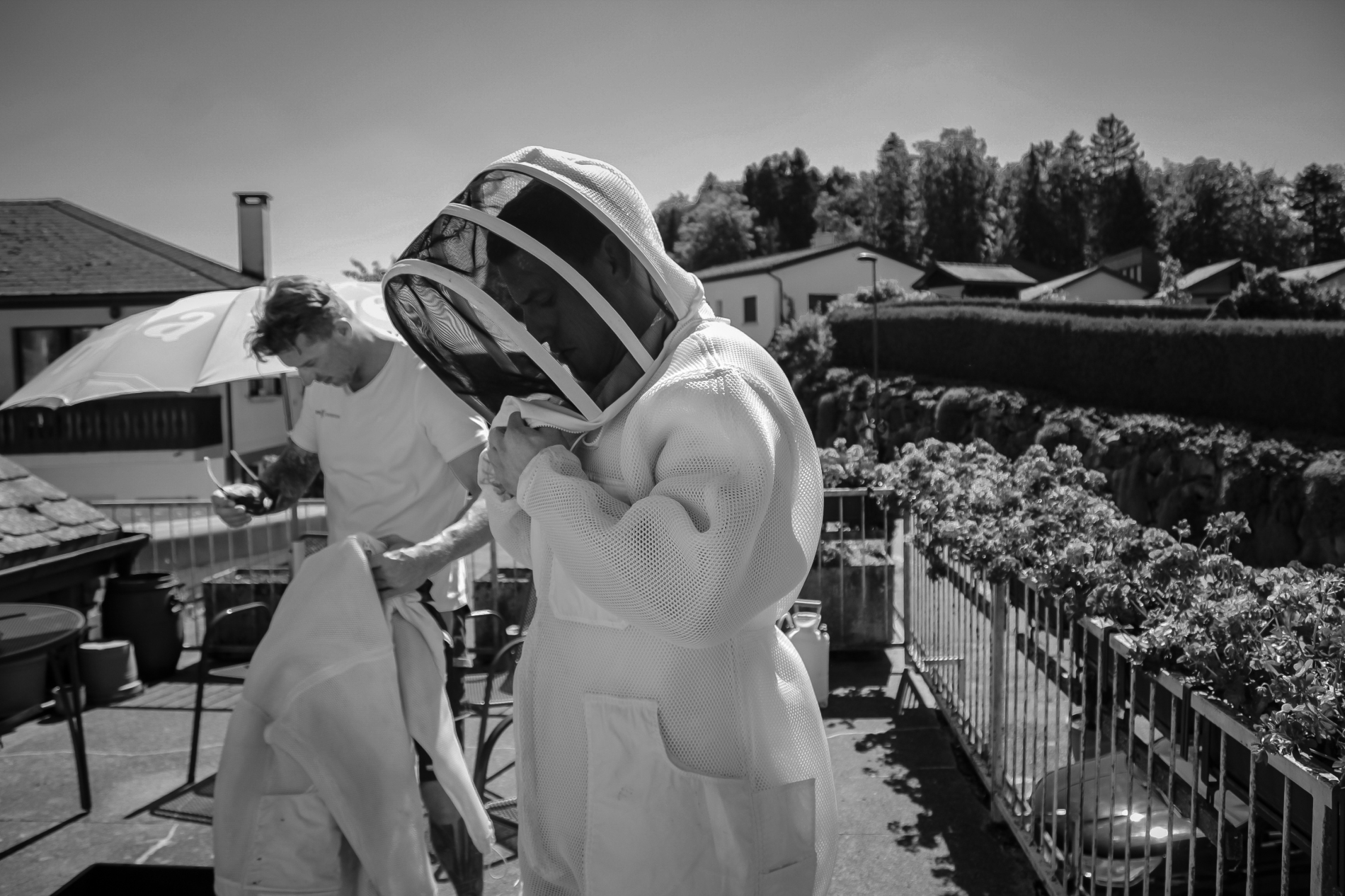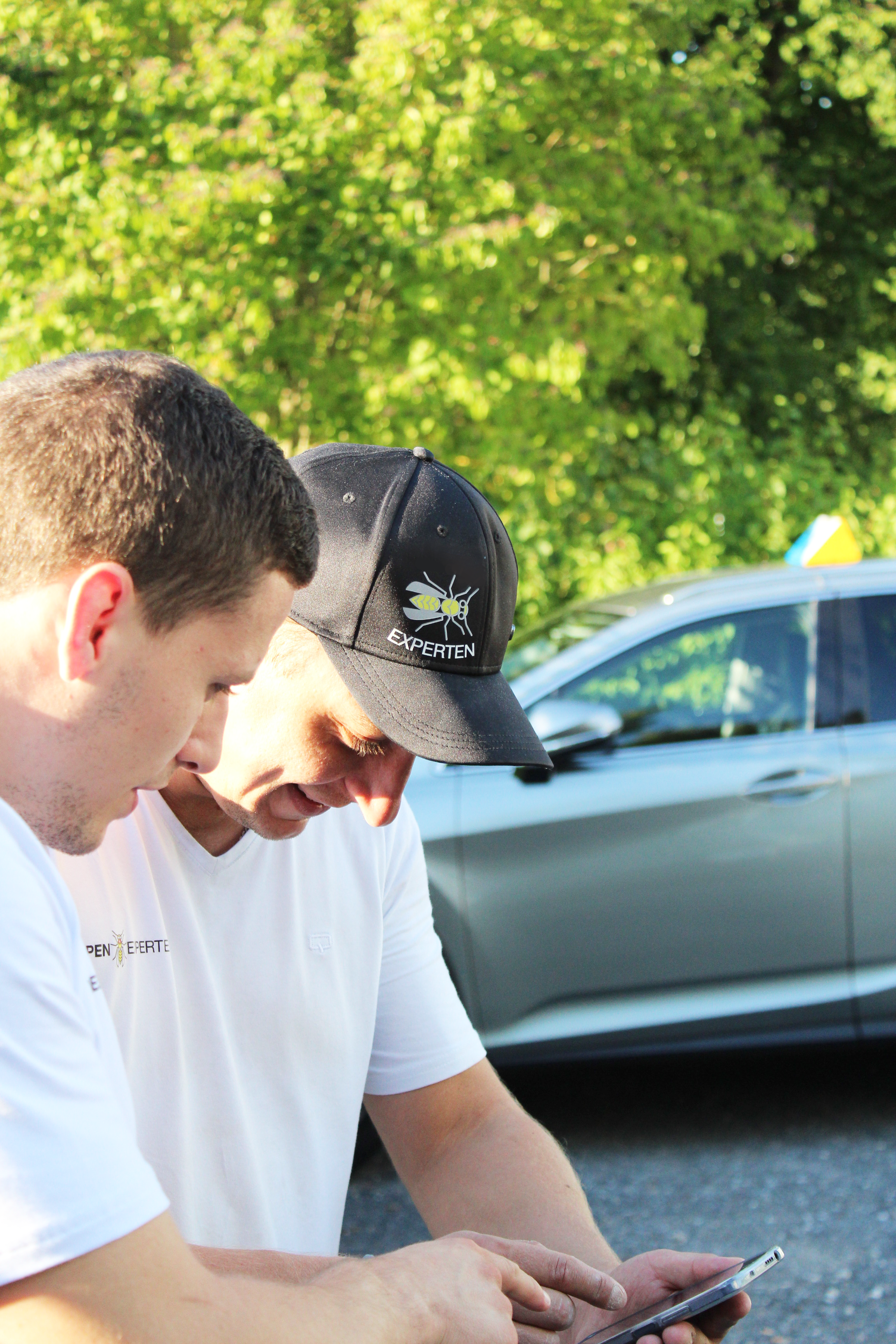
FAQ - Frequently asked questions from customers
All questions and answers to some of the most important questions about hornets that we have summarized with our customers.
Contact us today!
Questions and answers
At this point we have summarized for you answers to some of the most important questions that our customers continually ask us. If you need advice, please call us or arrange a personal appointment to have the nest removed.
Yes, hornets can be dangerous, especially when they feel threatened. Hornet stings can cause pain and lead to serious reactions in allergic people. However, it is recommended not to attack hornets and to avoid them to avoid stings.
Hornets feed primarily on insects and other small vertebrates, as well as nectar and pollen. They also hunt other insects to provide food for their offspring.
The size of hornets varies depending on the species, but in general they are larger than most other wasp species. Some species can grow up to 5 cm long, while others are only 1.5 to 2.5 cm long.
Yes, hornets can sting multiple times if they feel threatened or need to defend their nest. A hornet stinger contains a venom that is injected upon sting, but it can also be reused.
Hornets have a powerful, slender build and are typically brown or black in color, with yellow or orange stripes. They have long, thick legs and wings that usually lie folded on their backs. The head is broad and angular, with large eyes and a curved spine.
Hornets like to build their nests in secluded places, such as tree hollows, attics, walls, sheds and unused buildings. They also prefer places that are sheltered and dry. Some species also build their nests in open areas, such as in bushes or under branches. It is important to note that hornet nests should not be disturbed as the animals are very territorial and may attack if threatened.
The hornet queen has the most important role in the nest. Their job is to lay eggs and start the colony. The first eggs she lays will grow into workers, who will later be responsible for building the nest, feeding the offspring and hunting for food. The queen stays in the nest and continues to lay more eggs until the colony is numerous enough. The queen dies after completing her task and a new queen takes over.
If you have been stung by a hornet, you should take the following steps:
- Remove the stinger if it is visible.
- Cool the affected area with ice or cold water to relieve pain and swelling.
- Monitor for allergic reactions, such as shortness of breath, weakness, or dizziness.
- If you have an allergic reaction or notice other worrisome symptoms, seek medical help immediately.
- Continue to monitor the sting site for pain, swelling, or other changes and seek medical attention if necessary.
It is important to note that some people may have an allergic reaction to hornet venom and in these cases, immediate medical treatment is required.
It is best to seek professional help from a pest controller or wildlife expert to remove a hornet nest. Here are some reasons why:
- Hornets are very territorial and can be dangerous if their nest is threatened.
- The use of pesticides or other chemical agents can be dangerous and harm other animals or the environment.
- Hornet nests can be difficult to access and require specialized equipment and techniques for removal.
A pest controller or wildlife expert will be able to safely and effectively remove the nest without causing complications or danger to you or the environment.
Hornets are larger and have longer bodies than wasps. They also have a different coloration, often with a distinct yellow and black striped pattern. Hornets are generally more peaceful than wasps and will only attack if they or their nest are threatened. Wasps, on the other hand, tend to attack more quickly and are less tolerant of disturbances in their environment.
To prevent hornet nests, the following measures can be taken:
- Removal from possible nesting sites such as old tree holes or buildings
- Use of insect nets or screens to prevent access to buildings
- Using scents or smells that deter hornets
- Avoiding food sources near the house
- Professional removal of the nest by a pest controller.
Removing a hornet's nest should be done by an expert as hornets are aggressive animals and can pose a health threat. If the nest is near your home, contact a local pest control service. If the nest is in an inaccessible area, you can leave it alone and let nature process it.
The life cycle of hornets includes the following phases: egg, larva, pupa and adult hornet. The queen lays eggs, which are cared for by the workers. Larvae hatch from the eggs and are fed until they become pupae. The adult hornet emerges from the pupa.
On average, a hornet can live to be one year old. However, the queen of a hornet colony can live up to five years.
A hornet sting can cause the following symptoms: pain, swelling, redness, itching, nausea, shortness of breath (in rare cases).
A hornet's nest is usually recognizable as a round or oval structure with paper-like material made from clay, wood chips and plant fibers. It is often found in elevated locations, such as on trees, buildings or roof arches. Hornet activity near the nest is another indication.
To protect yourself from hornets, you can do the following:
- Avoid provoking her.
- Wear light-colored clothing and avoid strong perfumes.
- Avoid eating food outdoors.
- Keep your distance from their nests.
- Use insect repellent.
- In an emergency, you should move away slowly and not make any quick movements.
The habitat of hornets is primarily forests, parks and gardens, where they find nesting opportunities. They prefer tall trees, attics, sheds or other protected areas. However, hornets can also live in other environments such as cities, agricultural landscapes or coasts, as long as they find sufficient nesting opportunities and food sources.
Hornets typically have territorial behavior and aggressively defend their nest against threats. They can also hunt collectively and collect insects as food for their brood. During the breeding season, hornet queens are cared for and fed by their workers. Outside the breeding season, hornets can be peaceful and passive.
Hornets communicate through body language, smell and sound. They use certain behavioral patterns to signal threats or share the location of food sources. In addition, they use feromones to mark nests and other social information.
The queen of a hornet colony lays eggs, which hatch into larvae. The male hornets, also called drones, emerge from unfertilized eggs and have no working ability. Their only function is to mate with the queen. The female workers emerge from fertilized eggs and are responsible for building the nest, caring for the larvae and obtaining food.
Hornets defend their nest by launching aggressive attacks on threats. When they or their nest are threatened, they emit an alarm signal that spurs other hornets to defend themselves. They can use their spines repeatedly to ward off their attackers.
Some natural enemies of hornets are: birds of prey (e.g. owls, hawks), mammals (e.g. squirrels, raccoons), spiders, beetles, other insects.
Their natural enemies help keep population sizes in check and maintain a balanced ecosystem.
It is usually not recommended to remove a hornet's nest yourself, as hornets can be dangerous and have a stinging weapon. It is better to hire a professional pest controller to safely remove the nest.
A hornet's nest can be dangerous if approached too close or disturbed, as hornets are aggressive defenders of their nest and can sting quickly. Hornet stings can be painful and, in rare cases, cause allergic reactions that can even be fatal. It is important to take precautions when near a hornet's nest.
It is important to contact a professional pest controller to remove a hornet nest. These experts can remove the nest safely and efficiently without injuring or killing the hornets. If possible, one should try to keep the nest as far away from the people and animals in the house as possible to avoid a possible attack.
The hornet usually builds its nest in an unused corner of a building or outdoors on a tree or bushes. To do this, she uses wood fibers, leaves, pollen and other organic materials that she finds nearby. A nest usually consists of several cells stacked inside each other.
A hornet sting can be painful and itchy. There may also be swelling, redness, and bruising around the bite. In some cases, an allergic reaction can occur, which can include vomiting, shortness of breath, dizziness and circulatory problems.
If you are stung by a hornet, the first thing you should do is cool the site of the sting by placing an ice cube or cold pack on the affected area. After that, you should see a doctor to monitor a possible allergic reaction. Be careful when trying to remove the hornet or you could get stung even more.
To protect yourself from hornets, you should especially be careful not to leave open food or drinks near hornet nests. When near a nest, you should remain calm and move slowly to avoid irritating the hornets. If you then put on protective clothing, you can protect yourself from bites. You can also use insect repellents to keep hornets away.
Hornets are very territorial animals and can become aggressive if they feel threatened. They are not as aggressive as some other insects, but they can cause painful stings. If you don't disturb them, they are usually quiet and can be flown around without causing any problems.
The hornet life cycle begins in the spring when the queen emerges from hibernation and establishes a nest. She lays eggs and fertilized workers are the first to hatch from the eggs. These workers care for the queen and feed the larvae that hatch from the eggs. When the larvae finally hatch, they develop into adult hornets, which then live in the colonies as workers, drones or queens. The life cycle ends in the fall when the queen and drones die after mating and the workers leave the nest and overwinter alone.
Hornets reproduce through a process called mating. At the end of the summer, a male and female mate and the female then lays eggs in a nest she has built. In spring the larvae hatch from the eggs and are fed by the female until they finally grow into fully grown hornets.
There are a variety of natural predators that hunt hornets. These include owls, hawks, hawks, birds of prey, bats, lizards, snakes, hedgehogs, martens, weasels, foxes, cats, raccoons and other mammals. In some areas, birds of prey, buzzards and barn owls can also hunt hornets.
Hornets are protected because they are considered important components of ecosystems. They are important for pollinating plants, regulating pests and are extremely efficient insect eaters. Hornets are an important part of biodiversity and have an important function in maintaining ecosystems.
A hornet's nest is a relatively large structure that usually hangs on a tree, on a house wall or on another building. It is usually a ball made of clay, paper and other materials that the hornets use to build. On the outside of the nest there is a small opening through which the hornets fly out and enter. There may also be some small holes that serve as breathing holes. A hornet's nest may also be attached to another object such as a swing or lantern. It can also be built in the ground.
The cost of removing a hornet nest depends on several factors. On the one hand, the size of the nest plays a crucial role: if it is small and manageable, it may be possible to remove it with a suitable tool. In this case, the costs will generally be relatively low. However, larger nests that are located in hard-to-reach places usually have to be removed by experts. The costs can be significantly higher here. In any case, you should consult a professional who will estimate the cost of removal.
It is very important to only have hornet nests removed by a professional pest controller. Hornets pose a serious danger to humans if they feel threatened. The pest controller will carefully remove the nest and humanely move or remove the hornets.
To prevent hornets from building a nest, potential nesting sites must be blocked. For this purpose, all holes in the roof, wall, windowsill and other possible nesting places should be closed. To avoid further nesting sites, the walls can be treated with a smooth coat of paint, such as paint or wallpaper. This makes it difficult for hornets to build a nest in the wall. You should also trim the trees in your garden regularly to avoid possible nesting sites in branch holes.
Hornets live in most regions of the world. They prefer warm, dry areas and tend to settle in the cracks and crevices of trees, caves, old buildings and even human habitation. Hornets are social insects and form colonies with large nests. These nests are mostly found in hidden places such as under attics, tree hollows and even empty birdhouses.
Hornets can sting multiple times, but they usually only sting when they feel threatened. They usually don't become aggressive without reason.
Hornets can survive for about a week without food.
Birds do not typically eat hornets because they are much larger and stronger than most other insects eaten by birds. However, there are some birds that eat hornets, such as ravens, magpies, shrikes, starlings and jays.
Hornets do not like strong smells, especially unpleasant smells. They do not like strong perfumes, chemicals, smoke or other smells that they find disturbing.
There is no specific scent that is effective at repelling hornets. However, it is known that certain scents, such as citrus, peppermint and camphor, can be unpleasant to hornets and deter them from staying nearby. However, it is best not to provoke them and instead try to avoid them.
There are many different types of sprays that can be used against hornets. Some of these sprays contain insecticides that help reduce the hornet population. Some sprays can also help reduce hornet activity. If you wish to use a hornet spray, please always read the label instructions first to ensure proper use.
Hornets are social insects and build their nest communally. They use wood fibers, clay and plant juices to build their nest. Individual workers collect the materials while others assemble them to form the nest.
In nature, hornets are eaten by many animals such as birds, lizards, spiders, bats, snakes and even other insects.
Moving companies that specialize in moving hornet nests can move hornet nests. However, it is important to note that hornets can be dangerous and handling them should be done by experienced professionals to avoid the risk of stings.
It is best to hire a professional pest control company to remove hornets. A pest controller can safely and effectively remove the hornets and ensure they do not return.
Typically, hornet nests can only be relocated by qualified professionals, such as pest controllers or biologists, who have the expertise and equipment to safely handle and prevent hornets. It is important that hornet handling practices comply with applicable laws and regulations to protect both hornets and people. It is also important that anyone wishing to move a hornet's nest does not disturb or remove the nest on their own, as this can be dangerous.
Hornets are not fought, but rather observed and evaluated. If they pose a danger to people or animals, they can be removed with the help of a professional pest controller.
Hornets are usually picked up by a professional pest controller. Because hornets are highly protected, it is important that the pest control professional has the proper knowledge to treat them safely.
If you have problems with hornets, the following people or organizations can help:
- Pest control companies: These companies specialize in pest control, including hornets, and can help remove or relocate the nest.
- local forestry offices or agricultural offices
It is important that anyone seeking help with hornets ensure they are working with a qualified person or facility to avoid the risk of stings.
Hornets are active in the summer, from May to September. The lifespan of an adult hornet is about one season, but most die in the fall.
Hornets typically live about a year. Part of their population consists of old queens who can live up to five years.
Hornets usually build their nests in sheltered places, such as tree hollows, hollow branches, cracks in attics, cracks in buildings, chicken coops, sheds, garages, under roof tiles or in empty bird nests.
To report a hornet problem, contact a pest control company: These companies specialize in pest control and can help remove or relocate the hornet's nest.
It is important to ensure you are working with a qualified person or facility to avoid the risk of stings and effectively resolve the problem.
Hornets don't like direct sunlight. They prefer shady areas where they can hide. They also don't like bright artificial lights as these can irritate them and distract them.
If you find a hornet nest, you should contact a pest exterminator or pest control company.
Hornets build their nests in a variety of locations, including tree hollows, attics, trees, walls, closets, and other relatively inaccessible areas. They also build nests directly in the ground.
Hornets usually overwinter in a nest or cave. They gather in large groups to retain heat and survive the winter. When temperatures drop, hornets sleep to conserve energy.
Remove Hornets FAQ
Active throughout Switzerland
Head office 4143 Dornach




.jpeg)


_6.png)
.jpeg)
.jpeg)
_1.png)